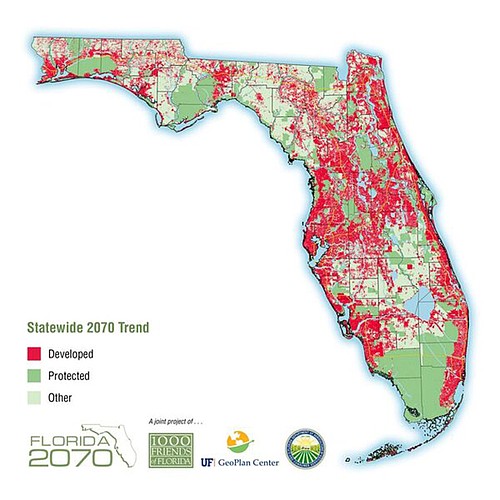Florida could be home to 15 million more residents by 2070 if conservative projections hold, a nearly doubling of the population that would have profound impacts on Gulf Coast commercial real estate markets.
And while 1,000 Friends of Florida's “Florida 2070” report and the finding that nearly 34 million people might live in the state five decades from now presents challenges for the Sunshine State's environment and natural resources, it would represent a boon to commercial real estate interests.
Central Florida, in particular, an area that includes the Gulf Coast, would become significantly denser in the next 54 years, the result of existing infrastructure, urban areas and availability of land for development.
“The Central Region will likely see the greatest absolute and relative increase in developed lands when compared with other regions,” the report states. “The population increase projected for this region is substantial.”
In 2010, the report notes, Central Florida had 2.73 million developed acres, out of 10.57 million acres total, based on Florida Bureau of Economic and Business Research statistics. By 2070, however, 5.11 million acres will be occupied — nearly double the total acreage.
Statewide, the report contends that by 2070, 11.6 million acres of the state's overall 34.5 million total will be developed, or 33.7%, up from 6.4 million acres in 2010.
The study further predicts that if development trajectories remain constant, more than 5 million acres of land could be converted to urban use by 2070, for a total of 11.6 million acres.
Already, Florida is experiencing an annual influx roughly equivalent to the population of the city of Tampa.
That influx will boost commercial real estate sectors such as multifamily, industrial and retail space primarily, analysts say.
“Industrial real estate, most notably, and population growth in an area go hand in hand,” says Mark Miller, director of Florida research for commercial brokerage firm JLL. “As more goods come into Florida, there's a need for more space to store them and distribute them from.”
Retail operators vying to capture a share of the fast-growing e-commerce market — like Wal-Mart Stores Inc. and Amazon.com, both of whom are positioned to service customers with massive distribution centers in the Interstate 4 corridor — would likely benefit, as well.
Miller adds that retail landlords who are able to adjust and redevelop their properties with customer experience and entertainment in mind also will reap the rewards of a greater population base.
And while some lenders have begun to pull back from providing multifamily loans amid an onslaught of new development in the past five years, Miller says he believes multifamily living will remain popular in Florida among millennials and baby boomers for years to come.
“It's hot, and the runway is long,” Miller says. “Nationwide, the home ownership percentage is at the lowest level since they started tracking it. It's now at 63%, and my guess is that figure will go further down. That's why multifamily is the sector where all the development is.”
But Miller and others caution that unbridled development — without critical infrastructure improvements to accompany it — would hamper long-term growth.
“Florida is already infrastructure starved,” Miller says. “Without solid infrastructure and mass transit going forward, the state as a whole will not be able to sustain its growth.”
1,000 Friends of Florida advocates for redevelopment and infill development to replace suburban sprawl as a way to sustain growth and maintain resources.
The group says denser, more compact development in existing towns and urban areas would save tax money that will need to be spent on roads, sewers and utilities. Building in established cities also could save as much as 1.5 million acres from being developed statewide.
“Even modest increases in development densities can result in substantial savings of land,” the group's report notes. “There are clear fiscal advantages to more compact development patterns.”
The nonprofit 1,000 Friends also says the state should establish incentives for farmers to preserve agriculture land, promote a range of housing types in projects and encourage a mix of transportation, including biking and public transportation, especially in urban areas.
Those suggestions dovetail with existing national trends toward reurbanization, says Ray Sandelli, managing partner of CRE Consultants, a commercial real estate brokerage firm in Fort Myers and Naples.
“Tampa has done a magnificent job of including its waterfront more into the urban lifestyle, even as population increases have occurred,” he says. “So has St. Petersburg.
“People come to Florida because of its natural resources, and that's partly why a majority of the people in the state live along the coasts, except for Orlando, which is a notable exception. Today, people want to be in cities, and redevelopment has become even more valid an option because it's becoming increasingly difficult to get projects through regulatory authorities when dealing with greenfields,” an undeveloped tract of land.
Vivian Young, a 1,000 Friends spokeswoman, says the report aimed to spark a larger conversation.
“Growth is in the forefront now as an issue on people's lives,” she says. “When you look at it cumulatively, it has a major impact. Hopefully this report brought the issue to the consciousness of a greater percentage of the general public, and it can be the foundation for further studies down the road.”






